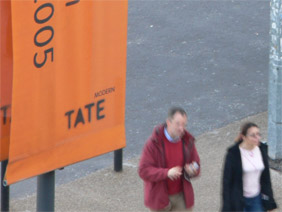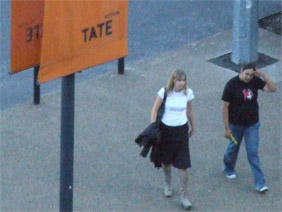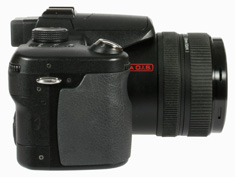Panasonic DMC-FZ30 review
-
-
Written by Gordon Laing
Panasonic FZ30 lens
The FZ30 is equipped with a long 12x optical zoom with an equivalent range of 35-420mm and an optically fast focal ratio of f2.8~3.7; the actual focal length is 7.4-88.8mm. Following a welcome trend in high-end all-in-ones, the zoom is operated by a tactile mechanically-linked ring, although unlike most of its rivals, the lens barrel doesn’t physically extend. The FZ30 and Fujifilm S9500 / S9000 are pictured below with the latter showing its extended lens barrel when zoomed-in. The FZ30 pictured below may be set to wide-angle, but the barrel does not extend when zoomed-in. A lens hood is supplied and the front lens element doesn’t rotate during focussing, allowing the easy use of polarising filters.
The FZ30’s 12x optical range is truly impressive in practice, with the telephoto end really pulling in distant detail, or throwing backgrounds out of focus on portraits. The wide-angle end is usable at 35mm, although many may prefer sacrificing the extreme long end for something wider, such as the 28mm option on the Fujifilm S9500 / S9000 or the impressive 24mm of Sony’s R1.
To illustrate the FZ30’s coverage, we took the same photo from the same position on a tripod using it and Fujifilm’s FinePix S9500 / S9000 which offers a 10.7x optical range equivalent to 28-300mm. The photos below were taken moments apart.
Zoomed-out to wide-angle, the Fujifilm S9500 captures a visibly wider field than the 35mm equivalent focal length of the Panasonic DMC-FZ30, although not as wide as the 24mm equivalent of Sony’s Cyber-shot DSC-R1.
Below are examples of both cameras zoomed all the way in, again taken from exactly the same position and moments apart. Here the massive 300 and 420mm equivalent focal lengths of each camera demonstrate their impressive reach over both the Sony R1’s 120mm equivalent, and the relatively paltry capabilities of a typical 3x lens bundled with a digital SLR. Note, there are similar lens coverage examples taken with the Sony R1 and Canon 350D / Digital Rebel XT from exactly the same spot, although on a different day in our Sony R1 review here.
The Panasonic unsurprisingly wins in this respect, although whether it’s offers a greater benefit than the wider angle of the Fujifilm S9500 is entirely down to personal preference and your style of photography.
Panasonic DMC-FZ30 |
Fujifilm FinePix S9500 Zoom | |
 |  | |
| 7.4-88.8mm at 88.8mm, f8 (420mm equivalent) | 6.2-66.7mm at 66.7mm, f8 (300mm equivalent) |
To counteract any potential camera shake, the FZ30 employs Panasonic’s Mega Optical Image Stabilisation technology, OIS. A button on the top surface of the camera allows you to choose between two modes or to disable it altogether. In use OIS certainly worked effectively, allowing us to handhold sharp exposures at 420mm using shutter speeds as slow as 1/15 of a second. It’s not just useful for long focal lengths either. With the lens at it’s widest position, OIS allowed us to handhold a 1/3 second exposure at f8 in order to achieve a large depth-of-field at a market stall – see Gallery page.
While OIS prevents the need to increase the ISO to prevent camera-shake at slower shutter speeds, it should be noted no amount of Image Stabilisation will freeze subjects which are in motion. As seen in the examples below, OIS allowed static subjects like the flag and background to remain sharp with a 420mm 1/15 exposure, but the people walking by became blurred. This may or may not be the effect you were after.
In contrast, Fujifilm has opted for a simpler electronic solution for its S9500 / S9000: simply increase the ISO to allow faster shutter speeds. So where most all-in-ones peak between 400 and 640 ISO, the S9500 offers sensitivity from 80 right up to 1600 ISO. This will certainly let you achieve the kind of shutter speeds required to avoid camera shake under most conditions. Of course by increasing sensitivity though, you also suffer from higher noise levels – see our results pages to compare the S9500 with the Panasonic FZ30, along with the Sony R1 and Canon EOS-350D which both feature physically larger sensors.
To illustrate the different approaches to combatting camera shake we took handheld photos of the same subject with both the FZ30 and Fujifilm S9500 / S9000 zoomed-in to their maximum focal lengths; the photos were taken within moments of each other. We’ve taken 1410×1060 pixel crops from each image to show similar areas, then reduced them by five times for 20% reproduction below. Each crop represents approximately 2/5 of the original image coverage. The FZ30 shows a smaller area because its focal length was longer and the resolution slightly lower. Despite slightly different resolutions, the reproduction of both crops from the original images is roughly equivalent and adequate to illustrate this example.
Panasonic DMC-FZ30 |
Fujifilm FinePix S9500 Zoom | |
 |  | |
|
7.4-88.8mm at 88.8mm, f8 (420mm equivalent) 80 ISO, 1/13th |
6.2-66.7mm at 66.7mm, f8 (300mm equivalent) 1600 ISO, 1/350th |
Set to 80 ISO, the FZ30 required a shutter speed of 1/13th of a second, but amazingly its optical image stabilisation allowed us to handhold the shot without any camera shake – and this was at a longer equivalent focal length of 420mm. At 80 ISO, the Fujifilm S9500 / S9000 also required a shutter speed of 1/13th, which for a focal length equivalent to 300mm was far too slow to handhold without considerable camera shake. Fujifilm’s answer is of course to increase the sensitivity, and once we’d set the camera to 1600 ISO, the exposure had shortened to 1/350th, allowing a sharp handheld result.
As explained earlier though, both approaches have their pros and cons. The high sensitivity demanded by the S9500 may have resulted in high noise levels and also some smearing of detail, but any motion has been frozen. In contrast the stabilisation of the Panasonic may have allowed us to handhold at 80 ISO and enjoy a noise-free image, but the long zoom and slow shutter speed have resulted in blurring of motion. Which is better depends on your style of photography. If you shoot moving subjects, the S9500’s higher sensitivity has the edge. Conversely if you shoot mostly static subjects the FZ30 will be more suitable. Either way, you can’t help but be impressed by the stabilisation of the Panasonic FZ30.
The FZ30’s autofocus system also feels quick and rarely do you find it searching for something to lock onto. Like other all-in-ones with long zooms, the FZ30 is manually focussed by an electrically-assisted ring. As you turn this ring, the central portion of the composition is magnified to allow easier focussing.
Again like other all-in-ones, manual focussing systems like these are simply not as accurate nor lend the same confidence as manually focussing on a true optical SLR. That said, the high resolution display on the FZ30 coupled with the magnified central portion allows you to manually focus about as accurately as you’re going to get with this kind of camera.
Sensor and files
The FZ30 employs an 8 Megapixel CCD sensor measuring 1/1.8in and delivering 4:3 aspect ratio images with a maximum of 3264×2448 pixels. A total of ten different resolutions are offered: five in the 4:3 aspect ratio, three in a wider 3:2 aspect ratio and two at 16:9. Images can be recorded in RAW, TIFF or JPEG formats, and there’s two compression levels for the latter; best quality JPEGs measure around 3.5MB each.
The FZ30 is equipped with an SD memory slot and our UK package was supplied with a 32MB card, although the particular bundle may vary depending on your region and the supplier’s offer.
Video recording
The FZ30 can shoot VGA 640 x 480 pixel video with mono sound at 10 or 30 fps, or QVGA 320 x 240 pixel video, again at 10 or 30 fps. All modes allow the use of zoom during recording. The 30 fps VGA mode was very smooth and detailed, consuming just over 1MB per second of recording.

Handling
The FZ30 starts up and is ready for action in about three quarters of a second, and while this is fractionally slower than most digital SLRs, it’s certainly nothing to be overly concerned about for general use. There’s a brief pause of about two seconds when you switch into Play mode before the first image appears, but subsequent images can be accessed and viewed after around one second. Nine image thumbnails are also available in around two seconds, while the 12 thumbnail option takes around three.
There are three continuous shooting modes, with a highest quoted speed of 3fps. We tested the FZ30 using a SanDisk Ultra II 1GB SD card at a shutter speed of 1/250 and found the FZ30 in its fastest mode could take up to five best quality JPEGs in 2.3 seconds, delivering an actual fps closer to 2.2fps. After taking five pictures, the camera pauses for a couple of seconds. You then have to let go of the shutter before pressing it again to take another burst, although unless you’re manually focussing, the camera will pause briefly to refocus at this time.
If you’d like more than five images in a sequence, you can switch to a different continuous mode which keeps shooting while you’ve got memory remaining – albeit at a slower rate. In this mode we shot 21 best quality JPEGs in ten seconds, delivering a rate of around 2fps.


7.4-88.8mm at 7.4mm, f8 (35mm equivalent)
6.2-66.7mm at 6.2mm, f8 (28mm equivalent)




